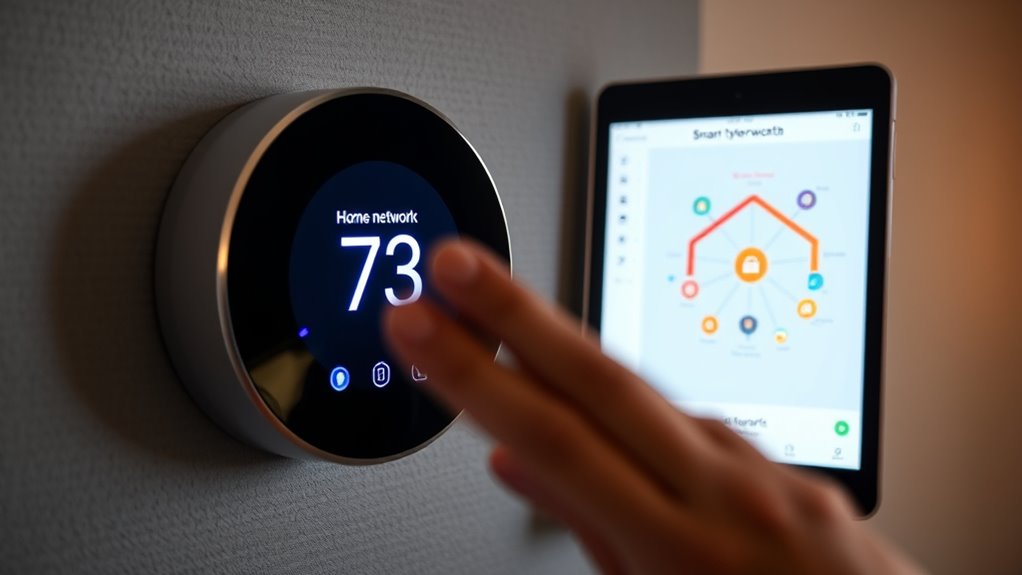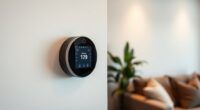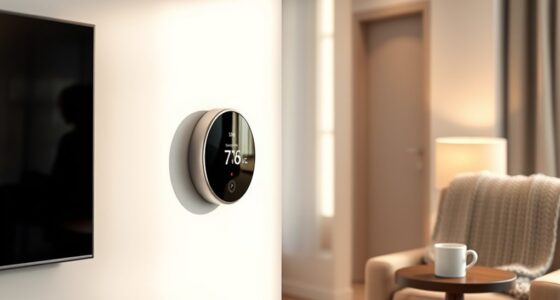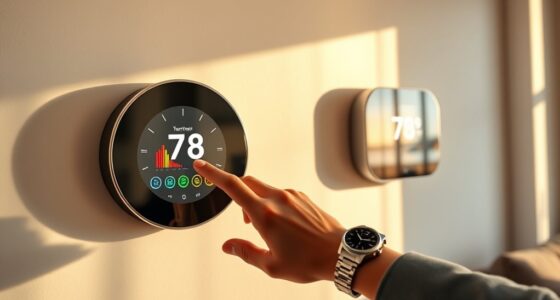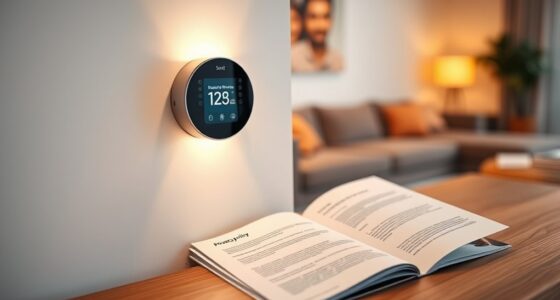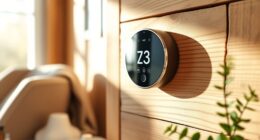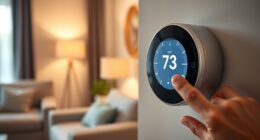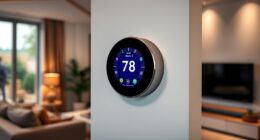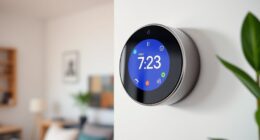To protect your home network from your smart thermostat, use strong, unique passwords and enable two-factor authentication if available. Keep device firmware updated with security patches, and change default credentials immediately. Creating a separate Wi-Fi network for your smart devices adds an extra layer of security, while reviewing privacy settings helps control data sharing. Staying vigilant about vulnerabilities and security best practices guarantees your smart thermostat remains safe—learn more to keep your home protected.
Key Takeaways
- Change default passwords and enable two-factor authentication to prevent unauthorized device access.
- Keep firmware updated regularly to patch security vulnerabilities.
- Use a separate Wi-Fi network for smart thermostats to isolate them from main devices.
- Review and adjust privacy settings to control data sharing and protect personal information.
- Enable WPA3 encryption and secure your Wi-Fi with a strong, unique password for added network security.
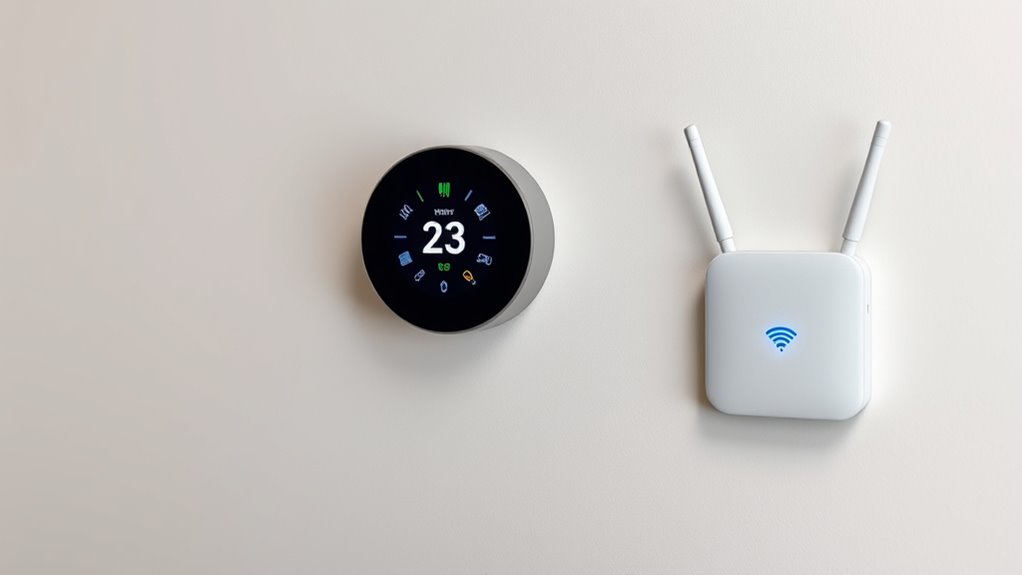
Smart thermostats offer convenience and energy savings, but they also introduce new security risks. When you install a smart thermostat, you’re not just upgrading your home’s comfort—you’re connecting a device to your Wi-Fi network, which can open the door to potential vulnerabilities. While these devices are designed to improve energy efficiency by adjusting temperatures based on your habits, they also handle sensitive data related to your daily routines. Protecting your user privacy becomes essential because, without proper safeguards, hackers could access your personal information, including when you’re home or away.
Your first step in securing your smart thermostat is ensuring it’s set up with a strong, unique password. Many users overlook this simple measure, leaving default passwords unchanged. Hackers often exploit these weaknesses to gain control of devices, which can lead to broader access to your home network. Changing the default credentials greatly reduces this risk. Additionally, enabling two-factor authentication (2FA) whenever possible adds another layer of security, making it harder for unauthorized users to access your account even if they have your password.
Set a strong, unique password and enable 2FA to protect your smart thermostat from unauthorized access.
Regularly updating the device’s firmware is essential because manufacturers often release security patches that fix known vulnerabilities. By keeping your smart thermostat’s software current, you stay one step ahead of potential threats. Also, review the privacy settings in the accompanying app. Some devices collect more data than necessary—such as your location or usage patterns—which could be misused if the company’s servers are compromised. Adjust these settings to limit data sharing and monitor what information is being stored. Implementing security best practices can further strengthen your defenses against attacks.
Another vital aspect is securing your home Wi-Fi network itself. Use a robust, unique password for your router, and enable encryption protocols like WPA3, which provide stronger protection against eavesdropping. Consider creating a separate network specifically for your smart devices, isolating them from your primary devices like computers and smartphones. This isolation prevents a breach of your thermostat from spreading to other critical devices on your network.
Furthermore, staying informed about device-specific vulnerabilities can help you respond promptly to emerging threats, ensuring your smart home remains secure. By proactively managing your device’s security settings and staying vigilant, you can enjoy the benefits of your smart thermostat—such as energy efficiency and comfort—without compromising your user privacy or home network security. Remember, understanding the importance of high-quality projectors can also help you make better decisions about your home technology.
Frequently Asked Questions
Can Smart Thermostats Be Hacked Remotely?
Yes, smart thermostats can be hacked remotely if security measures aren’t in place. Hackers might exploit weak passwords or vulnerabilities in remote access features. To protect your device, guarantee strong, unique passwords and keep firmware updated. Additionally, enable device encryption and secure your home Wi-Fi network. Taking these steps minimizes risks and keeps your smart thermostat safe from remote threats.
What Are the Best Security Practices for Smart Thermostats?
You should prioritize securing your smart thermostats by updating their firmware regularly, which patches vulnerabilities. Use strong, unique passwords and enable two-factor authentication when available. Limit smart home integration to trusted devices and disable voice control security features if you’re concerned about unauthorized access. Additionally, segment your Wi-Fi network to isolate smart devices from your main network, reducing potential risks if a device is compromised.
How Often Should I Update My Thermostat’S Firmware?
You should update your thermostat’s firmware regularly, ideally as soon as security patches become available. These updates fix vulnerabilities and improve performance, keeping your device secure. Check for firmware updates at least once a month, and enable automatic updates if possible. Staying current with firmware updates guarantees your thermostat benefits from the latest security patches, reducing the risk of hacking or unauthorized access to your home network.
Are There Specific Brands More Secure Than Others?
Imagine walking into your home on a chilly evening, expecting warmth, only to realize your thermostat’s security is shaky. Some brands prioritize device encryption and boast a strong manufacturer reputation, making them more secure. While no device is foolproof, researching brands known for robust security features helps protect your network. Look for those with regular updates and transparent security practices, giving you peace of mind during every temperature adjustment.
What Should I Do if My Thermostat Is Compromised?
If your thermostat is compromised, you should immediately change its password and enable strong network encryption. Make sure to update your firmware to patch any vulnerabilities. Use a password manager to create and store unique, complex passwords. Also, consider resetting your entire home network’s security settings to prevent further access. Regularly monitor your device activity and stay informed about security updates to protect your smart home.
Conclusion
Think of your smart thermostat as the heart of your home’s digital bloodstream. Guard it fiercely, like a knight shielding a treasure chest, to keep unwanted intruders at bay. With strong passwords and regular updates, you’re the captain steering your home’s security ship through stormy cyber waters. Stay vigilant and proactive—because in the digital age, a secure thermostat isn’t just a convenience, it’s the armor that keeps your home safe and sound.
